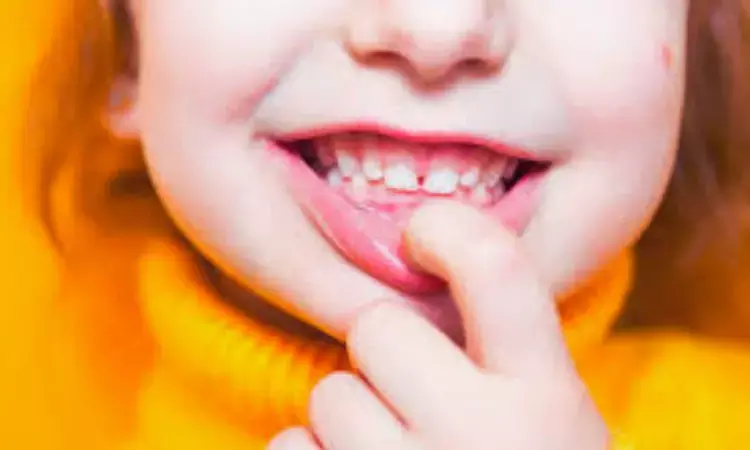- Home
- Medical news & Guidelines
- Anesthesiology
- Cardiology and CTVS
- Critical Care
- Dentistry
- Dermatology
- Diabetes and Endocrinology
- ENT
- Gastroenterology
- Medicine
- Nephrology
- Neurology
- Obstretics-Gynaecology
- Oncology
- Ophthalmology
- Orthopaedics
- Pediatrics-Neonatology
- Psychiatry
- Pulmonology
- Radiology
- Surgery
- Urology
- Laboratory Medicine
- Diet
- Nursing
- Paramedical
- Physiotherapy
- Health news
- Fact Check
- Bone Health Fact Check
- Brain Health Fact Check
- Cancer Related Fact Check
- Child Care Fact Check
- Dental and oral health fact check
- Diabetes and metabolic health fact check
- Diet and Nutrition Fact Check
- Eye and ENT Care Fact Check
- Fitness fact check
- Gut health fact check
- Heart health fact check
- Kidney health fact check
- Medical education fact check
- Men's health fact check
- Respiratory fact check
- Skin and hair care fact check
- Vaccine and Immunization fact check
- Women's health fact check
- AYUSH
- State News
- Andaman and Nicobar Islands
- Andhra Pradesh
- Arunachal Pradesh
- Assam
- Bihar
- Chandigarh
- Chattisgarh
- Dadra and Nagar Haveli
- Daman and Diu
- Delhi
- Goa
- Gujarat
- Haryana
- Himachal Pradesh
- Jammu & Kashmir
- Jharkhand
- Karnataka
- Kerala
- Ladakh
- Lakshadweep
- Madhya Pradesh
- Maharashtra
- Manipur
- Meghalaya
- Mizoram
- Nagaland
- Odisha
- Puducherry
- Punjab
- Rajasthan
- Sikkim
- Tamil Nadu
- Telangana
- Tripura
- Uttar Pradesh
- Uttrakhand
- West Bengal
- Medical Education
- Industry
Identifying atypical deglutition in children with OSAS could help guide personalized therapeutic approach: Study

France: A recent study published in the Journal of Sleep Research has shown that atypical deglutition (tongue thrust) is associated with more severe apnea in children with obstructive sleep apnea syndrome (OSAS). Atypical deglutition was more strongly associated with altered facial measurements and increased pharyngeal collapsibility in children.
The findings suggest that identifying atypical deglutition in children with OSAS could help to guide a personalized therapeutic approach, including myofunctional therapy.
Previous studies have proposed a link between atypical deglutition and pediatric obstructive sleep apnea syndrome and that its correction through myofunctional therapy could potentially ameliorate OSAS symptoms. The role of myofunctional therapy in managing pediatric OSAS remains debatable. Plamen Bokov, INSERM NeuroDiderot, Paris, France, and colleagues aimed to assess the prevalence of atypical deglutition in children diagnosed with moderate to severe OSAS and to explore its associations, particularly concerning the type of dentition (mixed or permanent).
For this purpose, the researchers conducted a study over 5 years at a pediatric hospital in Paris, France. It included children aged 6–18 years with moderate to severe OSAS (apnea–hypopnea index ≥5/h) who underwent a comprehensive evaluation, including the symptoms of snoring and breathing issues, recording of demographic data, and otolaryngology examination.
The swallowing pattern was evaluated, and orthodontic evaluations were performed. The researchers conducted cophalometric radiography and pharyngometry tests (pharyngeal collapsibility was computed).
The researchers reported the following findings:
- There was a high prevalence of atypical deglutition in children with mixed 74% or permanent 38% dentition.
- In children with mixed dentition and atypical deglutition, there was an increase in pharyngeal compliance and lower facial dimensions.
- Atypical deglutition was associated with more severe OSAS and a lower hyoid bone position in children with permanent dentition.
- Independent of the type of dentition, atypical deglutition was associated with an increase in the apnea–hypopnea index, an increase in the lower facial dimension, increased pharyngeal compliance, and a more caudal hyoid bone position.
- Atypical deglutition was strongly associated with increased pharyngeal collapsibility, more severe OSAS, and altered facial measurements in children.
In conclusion, in children with moderate to severe OSAS diagnosis, the presence of atypical deglutition is associated with increased pharyngeal collapsibility and a more severe apnea–hypopnea index, as well as with distinctive facial features, characterized by increased proportions of the lower part of the face and a lower position of the hyoid bone.
"Thus, it is crucial to recognize atypical deglutition as a potential risk factor contributing to the severity of OSAS in children," the researchers wrote. Consequently, they recommend considering early intervention through myofunctional therapy as a viable treatment approach.
Reference:
Bokov, P., Dahan, J., Boujemla, I., Dudoignon, B., & Delclaux, C. The role of atypical deglutition in children and adolescents with moderate to severe obstructive sleep apnea syndrome. Journal of Sleep Research, e14175. https://doi.org/10.1111/jsr.14175
Dr Kamal Kant Kohli-MBBS, DTCD- a chest specialist with more than 30 years of practice and a flair for writing clinical articles, Dr Kamal Kant Kohli joined Medical Dialogues as a Chief Editor of Medical News. Besides writing articles, as an editor, he proofreads and verifies all the medical content published on Medical Dialogues including those coming from journals, studies,medical conferences,guidelines etc. Email: drkohli@medicaldialogues.in. Contact no. 011-43720751


